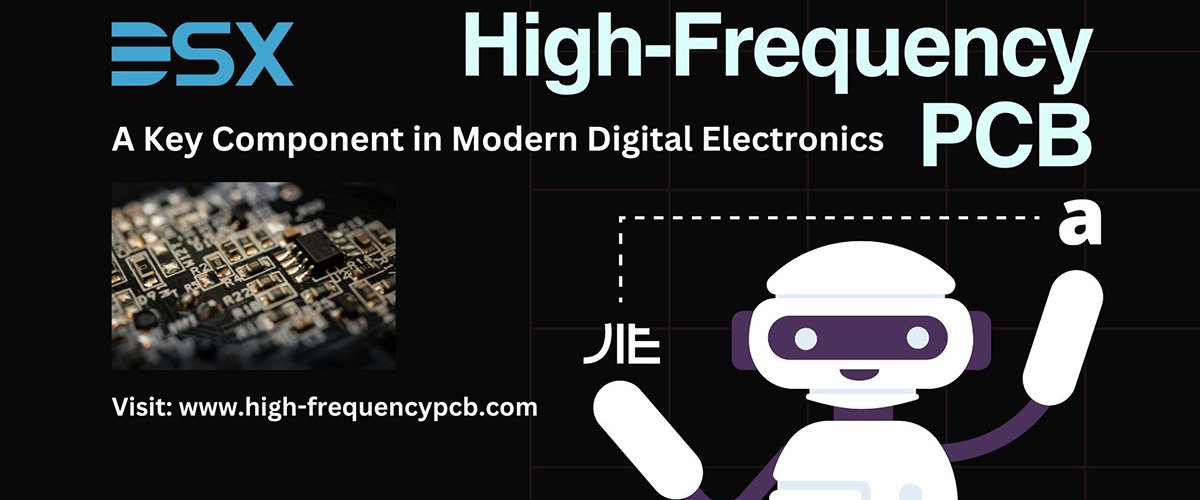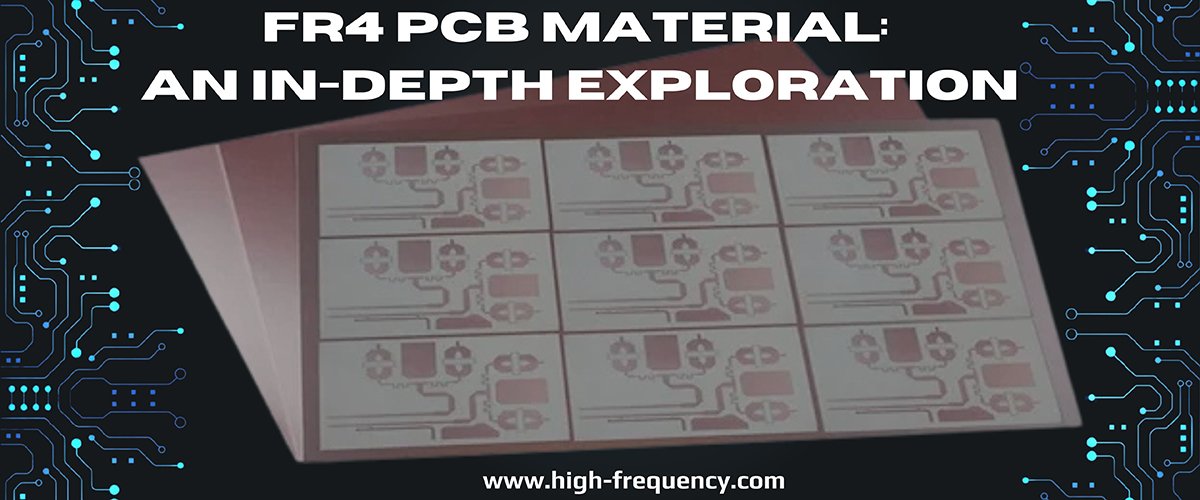High-Frequency PCB: A Key Component in Modern Digital Electronics

Introduction
High-frequency PCBs (Printed Circuit Boards) are specialized circuit boards designed to operate at frequencies typically above 1 GHz. They are crucial for applications requiring fast signal transmission with minimal loss and interference. These PCBs are widely used in advanced digital electronics, including telecommunications, radar systems, medical equipment, and high-speed computing devices.
High-Frequency PCBs
High-frequency PCBs are designed to handle rapid signal transmissions with minimal interference, making them essential for modern high-speed digital and RF applications. These PCBs use specialized materials like PTFE (Teflon) and Rogers substrates, which have low dielectric constants and loss tangents to ensure superior electrical performance. Their construction involves precise impedance control, high thermal stability, and excellent mechanical durability, making them ideal for critical applications such as 5G networks, radar systems, and aerospace technologies. By reducing signal attenuation and ensuring high-speed data processing, high-frequency PCBs play a pivotal role in advancing modern electronics.
Applications of High-Frequency PCBs
High-frequency PCBs play a critical role in modern electronic systems where high-speed signal transmission and minimal interference are essential. They are extensively used in wireless communication systems such as 5G networks, RF modules, and satellite communications, ensuring reliable connectivity and data transmission. In the automotive industry, these PCBs are fundamental for radar systems that enable collision avoidance and autonomous driving. Medical equipment, including MRI scanners and advanced imaging devices, rely on high-frequency PCBs for accurate diagnostics. Aerospace and defense sectors use these PCBs in radar, avionics, and military communication systems due to their ability to withstand extreme conditions while maintaining signal integrity. Additionally, high-frequency PCBs are crucial in high-speed computing, supporting data centers, high-performance routers, and network infrastructure for seamless and efficient data processing.
High-frequency PCBs are extensively used in various digital and communication technologies, including:
1. Wireless Communication Systems - Used in 5G networks, RF modules, and satellite communication.
2. Automotive Radar Systems - Essential for collision avoidance and autonomous driving.
3. Medical Equipment - Applied in MRI scanners and other high-frequency imaging devices.
4. Aerospace and Defense - Utilized in radar and avionics for efficient signal processing.
5. High-Speed Computing - Necessary for data servers and network routers requiring fast processing speeds.
Advantages of High-Frequency PCBs
High-frequency PCBs provide several advantages that make them superior to conventional PCBs in high-speed applications. They offer low signal loss, ensuring efficient transmission with minimal attenuation, which is crucial for applications like 5G and radar systems. Their improved electrical performance helps maintain signal integrity, reducing interference and enhancing reliability. These PCBs exhibit high thermal stability, allowing them to withstand extreme temperatures without performance degradation. Additionally, they have a low dielectric constant (Dk) and loss tangent, which helps in minimizing signal distortion. The compact design of high-frequency PCBs enables the development of miniaturized electronic devices without sacrificing performance. Overall, their enhanced durability and superior performance justify their higher cost, making them the preferred choice for high-speed and high-frequency applications.
High-frequency PCBs provide several advantages that make them superior to conventional PCBs in high-speed applications:
1. Low Signal Loss - Reduces attenuation, ensuring efficient signal transmission.
2. Improved Electrical Performance - Maintains signal integrity and reduces interference.
3. High Thermal Stability - Resistant to high temperatures, making them reliable for extreme environments.
4. Low Dielectric Constant (Dk) and Loss Tangent - Essential for minimal signal degradation.
5. Enhanced Reliability - High-performance materials like PTFE ensure durability and long-term performance.
6. Compact Design - Allows for miniaturization of components without compromising performance.
High-Frequency PCB vs. Standard PCB
High-frequency PCBs differ significantly from standard PCBs in terms of materials, signal integrity, and performance. While standard PCBs, typically made from FR4 material, are sufficient for most consumer electronics, they struggle with high-frequency applications due to higher signal loss and dielectric constant. In contrast, high-frequency PCBs use advanced materials like PTFE, Rogers, and ceramic composites to minimize signal degradation and enhance thermal stability. These properties make high-frequency PCBs ideal for RF and microwave applications, telecommunications, and aerospace industries where precise signal transmission is critical. Despite their higher cost, high-frequency PCBs offer unparalleled efficiency and durability, making them the preferred choice for high-speed electronic designs.
Feature | High-Frequency PCB | Standard PCB |
Frequency Range | >1 GHz | <1 GHz |
Material | PTFE, Rogers, Ceramic | FR4, Epoxy Resin |
Signal Loss | Low | Higher |
Dielectric Constant | Low (2.2-3.5) | Higher (>4) |
Thermal Stability | High | Moderate |
Cost | Higher | Lower |
Applications | RF, 5G, Radar, Medical Imaging | General Electronics, Consumer Devices |
Material Comparison for High-Frequency PCBs
High-frequency PCBs rely on advanced materials to ensure optimal performance in high-speed applications. The material selection directly impacts signal integrity, thermal stability, and overall efficiency. Rogers 4350B, for example, is known for its excellent dielectric properties and minimal signal loss, making it a popular choice in RF applications. Taconic RF-35 offers a balance between performance and cost, with low loss tangent properties. PTFE (Teflon) provides the lowest dielectric constant, ensuring minimal signal degradation but at a higher manufacturing cost. In contrast, FR4, a standard PCB material, has higher loss and dielectric values, making it less suitable for high-frequency applications.
Material | Dielectric Constant (Dk) | Loss Tangent | Temperature Stability |
Rogers 4350B | 3.48 | 0.0037 | Excellent |
Taconic RF-35 | 3.5 | 0.0018 | Good |
PTFE (Teflon) | 2.2 | 0.002 | High |
FR4 (for comparison) | 4.2-4.7 | 0.02 | Moderate |
Why Choose DSX Electronics for Your High-Frequency PCBs?
Choosing us for your high-frequency PCB needs ensures top-tier quality, latest technology, and expert engineering. We specialize in manufacturing high-performance PCBs using premium materials like Rogers and PTFE to deliver optimal signal integrity and minimal loss. Our state-of-the-art facilities and stringent quality control processes guarantee precision and reliability in every board we produce. Whether you need PCBs for RF applications, 5G networks, or aerospace technology, our experienced team is dedicated to providing customized solutions that meet your exact specifications. Partner with us for innovative, high-speed PCB solutions that set new industry standards.
Conclusion
High-frequency PCBs are an integral part of modern high-speed digital and communication technologies. Their superior performance, reduced signal loss, and reliability make them indispensable in applications where standard PCBs fall short. Despite their higher cost, the advantages they offer far outweigh the investment, ensuring efficiency and durability in advanced electronic systems.
For industries dealing with RF applications, telecommunications, and aerospace, opting for high-frequency PCBs is the best way to ensure the best performance and reliability.
 High-Frequency PCB: A Key Comp
High-Frequency PCB: A Key Comp
 High-Frequency PCBs Design, Ma
High-Frequency PCBs Design, Ma
 Miniaturization and High-Densi
Miniaturization and High-Densi
 FR4 PCB Material An In-Depth E
FR4 PCB Material An In-Depth E
